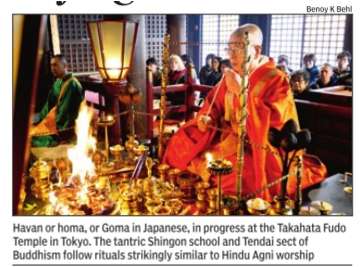Hinduism and Buddhism
This is a collection of articles archived for the excellence of their content. |
Hindu deities in Japanese Buddhism
The Times of India Jan 11 2016
Krishnendu Bandopadhyay
Kolkata
Did you know that at least 20 Hindu deities are regularly worshipped in Japan? In fact, there are hundreds of shrines to goddess Saraswati alone in that country, along with innumerable representations of Lakshmi, Indra, Brahma, Ganesha, Garuda and others.
Even deities forgotten in India are worshipped in Japan. An exhibition of rare photos at the Indian Museum, opening on Monday , is set to throw light on the country's long lost history that survives in a foreign land.
The research that accom panies art-historian Benoy Behl's photographs offers rare, heart-warming glimps es of the importance of Indian heritage in Japan.
For instance, the 6th cen tury Siddham script is preserved in Japan, though it has disappeared from India.`Beejaksharas' of Sanskrit (“seed syllables“ that are also mantras) in this script are regarded as holy. Each deity has an assigned `Beejakshara' and these are venerated by the people, even though most of them cannot read it. Some Japanese tombs are adorned with the Sanskrit alphabet.
At Koyasan, they still have a school where Sanskrit is taught in Siddham, Behl's research reveals.
A number of words in Japanese have their roots in Sanskrit. In Japanese supermarkets, a major brand of milk products is called `Suja ta'. The company's personnel are taught the story of Sujata who gave sweet rice-milk to the Buddha, with which he broke his period of austerity , before he achieved enlightenment. “All this and more are revealed through Behl's photography ,“ Indian Museum education officer Sayan Bhattacharya said.
Behl writes in his research, “In many ways, this philosophic understanding is most well preserved in Japan. Japan has not had the breakdown of cultural norms which India suffered when a colonial education system was created“. Behl wrote in his research, “Therefore, most Indians learnt about our own culture from the Western point of view. The dominant and admired language was English, which it remains till today .“
The Japan Foundation and filmmaker and art-historian Benoy K Behl have collaborated to hold an exhibition of rare photographs that will be inaugurated on Monday and will continue until January 21.
“The exhibition will be a rare treat for the eyes and the mind,“ said Indian Museum education officer Sayan Bhattacharya.
The National Geographic had carried an 18-page story on ancient Indian art revealed through Behl's photography to the world. The exhibition will also explain India's relationship with Japan.
Human-animal deities in Hinduism, Buddhism, Jainism
The Times of India, January 30, 2016
MT Saju
Man-animal forms adorn temples but remain a mystery From the Sphinx -a lion with a head of human -to the Garuda -a gigantic eagle with a human body -mythological characters with body parts of more than one species or hybrid forms are common to all religions across the world.Even the Jains and Buddhists have used it in their pantheons, according to P Sumabala, an expert on hybrids. Despite their wide prevalence they remain decorations in temples and little study is done on them. “The fabulous combinations of human and animal or bird forms have resulted in numerous types of deities in Indian mythology . The most important among them are the kinnaras (centaurs).The sculptural and iconographic texts of the Hindus, Buddhists and Jains reflect several such instances of composite symbiotic forms of humans and animals. At Nal anda, we can see the kinnaras with foliated tails and `makara' (sea creature) designs,“ said Sumabala, while speaking on “Therianthrop ic or hybrid forms in Indian Iconography“ at a seminar held recently in Chennai. She said the depic tion of kinnaras in early Indian art was recurrent and the ancient sculptures of Sanchi, Barhut, Amaravati, Nagarjunakonda, Mathura and the paintings of Ajanta invariably depicted kinnaras. “They are seen in the sculptures flanking the stupas. Sometimes, the kinnaras appear in the sculptures holding a garland in the right hand and a tray in the left. They also appear before dharmachakras or as playing a musical instrument. Kinnaras are common in early Indian sculpture.Unfortunately, only a few have studied the subject in detail,“ she said. The term `ihamr . ga' (imaginary anit mals) was used in early days to refer to fabulous animals.
The Hellenic mythology , according to Sumabala, also rec ognises the existence of composite animals of which the most common are the centaurs, kentaurides, chiron, cherubs and sphinx.“Such curious combinations of animals and human limbs have been conceived in Greek history .The famous Greek king Midas had the ears of an ass. Literary as well as historical traditions all over the world helps us conclude that such queer shaped creatures were not merely the figment of a poet's imagination but were executed in art too,“ she said.
